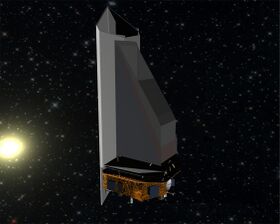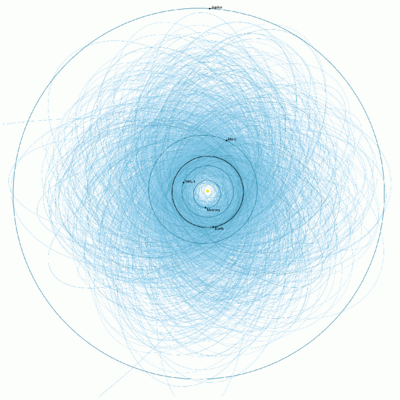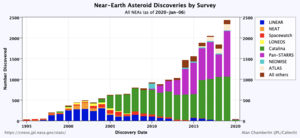Astronomy:Near-Earth Object Camera
 | |
| Mission type | Astronomy |
|---|---|
| Operator | NASA / JPL |
| Website | neocam |
| Mission duration | Proposed: 4 years |
| Start of mission | |
| Launch date | Proposed: 2021 |
| Orbital parameters | |
| Reference system | Heliocentric |
| Regime | Sun–Earth L1 |
| Main telescope | |
| Diameter | 50 cm (20 in) |
| Wavelengths | Infrared (4–5.2 & 6–10 µm) |
The Near-Earth Object Camera (NEOCam) is a proposed space-based infrared telescope designed to survey the Solar System for potentially hazardous asteroids.[1][2] NEOCam would survey from the Sun–Earth L1 Lagrange point, allowing it to look close to the Sun and see objects inside Earth's orbit.[3][4] NEOCam would be the successor of the NEOWISE mission; the principal investigator is NEOWISE's principal investigator, Amy Mainzer of NASA's Jet Propulsion Laboratory.[5]
Proposals for NEOCam were submitted in 2006, 2010, and 2015 to the NASA Discovery Program. In 2010, NEOCam was selected to receive technology development funding to design and test new detectors optimized for asteroid and comet detection and discovery.[6][7] On 30 September 2015, the Discovery Program advanced NEOCam along with other four candidate missions for refinement during the next year, with each mission receiving US$3 million for a one-year study.[8][9][10] Although it was not successful in the 4 January 2017 selection of the next two Discovery missions, it was given an additional year of development funding.[11]
Overview
The primary scientific goal of NEOCam is to discover and characterize the orbit of most of the potentially hazardous asteroids larger than 140 meters (460 ft) over the course of its four-year mission. NEOCam's field of view would be large enough to allow the mission to discover tens of thousands of new NEOs with sizes as small as 30 m (98 ft) in diameter.[12] Secondary science goals include detection and characterization of approximately one million asteroids in the asteroid belt and thousands of comets, as well as identification of potential NEO targets for human and robotic exploration.[13][14]
In 2016, the NEOCam team proposed to launch in 2021 and find two-thirds of missing objects in the larger-than-140-meters category within four years.[15]
Scientific payload
The primary instrument is a 50-centimeter (20 in) infrared telescope operating in two wavelengths, 4–5.2 µm and 6–10 µm,[14] with a large field of view of 11.56 square degrees.[16] It would use a modified version of a mercury–cadmium–telluride detector called the HgCdTe Astronomical Wide Area Infrared Imager (HAWAII) developed by Teledyne Imaging Sensors,[17] the mission prototype of which was successfully tested in April 2013.[18] The detector array would be 2,048 × 2,048 pixels and produce 82 gigabits of data per day.[16] The detector has good infrared performance without the use of cryogenic fluid refrigeration;[17] it would be passively cooled to 30 K (−243 °C; −406 °F) using techniques proven by the Spitzer Space Telescope.[16]
The spacecraft would operate in a halo orbit around the Sun–Earth L1 point, and employ a Sun shield.[16] This orbit would allow fast data downlink speeds to Earth, allowing full-frame images to be downloaded from the telescope.[19]
Images


| LINEAR NEAT Spacewatch LONEOS | CSS Pan-STARRS NEOWISE All others |
See also
- Discovery program finalists with this mission
- DAVINCI, a proposed Venus entry probe
- Lucy (spacecraft), a planned asteroid fly-by mission
- Psyche (spacecraft), a planned asteroid orbiter
- VERITAS (spacecraft), a proposed Venus orbiter
- NEOs search projects
- B612 Foundation, an organization that studied NEOs and proposed a similar mission
- Near Earth Object Surveillance Satellite, a Canadian small satellite intended to detect NEOs
- The Spaceguard Foundation, an organization that attempts to locate NEOs
- Whipple (spacecraft), a proposed space telescope in the Discovery program
- Asteroid Terrestrial-impact Last Alert System, a ground-based NEO detection system started by NASA at the end of 2015
References
- ↑ Chang, Kenneth (6 January 2017). "A Metal Ball the Size of Massachusetts That NASA Wants to Explore". The New York Times. https://www.nytimes.com/2017/01/06/science/nasa-psyche-asteroid.html. Retrieved 7 January 2017.
- ↑ "NEOCam website". NASA/Jet Propulsion Laboratory. 15 April 2013. http://neocam.ipac.caltech.edu/. Retrieved 6 July 2013.
- ↑ "NEOCam - Orbit". NASA/Jet Propulsion Laboratory. http://neocam.ipac.caltech.edu/page/Orbit. Retrieved 6 July 2013.
- ↑ Mainzer, Amy K. (September 2006). "NEOCam: The Near-Earth Object Camera". Bulletin of the American Astronomical Society 38 (3): 568. Bibcode: 2006DPS....38.4509M.
- ↑ "Amy Mainzer: NEOWISE Principal Investigator". NASA/Jet Propulsion Laboratory. 25 August 2003. https://science.jpl.nasa.gov/people/Mainzer/. Retrieved 6 July 2013.
- ↑ "NEOCam - Mission". NASA/Jet Propulsion Laboratory. https://neocam.ipac.caltech.edu/page/mission. Retrieved 6 July 2013.
- ↑ "NASA Announces Three New Mission Candidates". Discovery News. NASA. 5 May 2011. Archived from the original on 14 June 2013. https://web.archive.org/web/20130614124600/http://discovery.nasa.gov/news/index.cfml?ID=1034.
- ↑ Clark, Stephen (7 September 2016). "NASA official says new mission selections on track despite InSight woes". Spaceflight Now. https://spaceflightnow.com/2016/09/07/nasa-official-says-new-mission-selections-on-track-despite-insight-woes/. Retrieved 8 September 2016.
- ↑ Clark, Stephen (24 February 2014). "NASA receives proposals for new planetary science mission". Spaceflight Now. http://spaceflightnow.com/2015/02/24/nasa-receives-proposals-for-new-planetary-science-mission/. Retrieved 25 February 2015.
- ↑ Kane, Van (2 December 2014). "Selecting the Next Creative Idea for Exploring the Solar System". The Planetary Society. http://www.planetary.org/blogs/guest-blogs/van-kane/20141201-selecting-the-next-creative-discovery-mission.html. Retrieved 10 February 2015.
- ↑ Voosen, Paul (4 January 2017). "Updated: NASA taps missions to tiny metal world and Jupiter Trojans". Science. http://www.sciencemag.org/news/2017/01/updated-nasa-taps-missions-tiny-metal-world-and-jupiter-trojans.
- ↑ "NEOCam - Instrument". NASA/Jet Propulsion Laboratory. http://neocam.ipac.caltech.edu/page/Instrument. Retrieved 12 November 2015.
- ↑ "NEOCam - Science". NASA/Jet Propulsion Laboratory. http://neocam.ipac.caltech.edu/page/science. Retrieved 6 July 2013.
- ↑ 14.0 14.1 Mainzer, Amy K. (October 2016). "NEOCam: The Near-Earth Object Camera". 48th Meeting of the Division for Planetary Sciences. 16-21 October 2016. Pasadena, California.. Bibcode: 2016DPS....4832701M.
- ↑ Mosher, Dave (13 January 2017). "City-killing asteroids will inevitably strike Earth — but NASA isn't launching this mission to hunt them down". Business Insider. http://www.businessinsider.com/neocam-mission-not-fully-funded-nasa-2017-1.
- ↑ 16.0 16.1 16.2 16.3 Mainzer, Amy K. (18 November 2009). "NEOCam: The Near-Earth Object Camera". 2nd Small Bodies Assessment Group Meeting. 18-19 November 2009. Boulder, Colorado.. https://www.lpi.usra.edu/sbag/meetings/sbag2/presentations/Mainzer_SBAG2009_NEOCam.pdf.
- ↑ 17.0 17.1 "Near Earth Object Camera (NEOCam)". Teledyne Scientific & Imaging. Archived from the original on 28 September 2015. https://web.archive.org/web/20150928021627/http://www.teledyne-si.com/learn-more-neocam.html.
- ↑ "NASA-Funded Asteroid Tracking Sensor Passes Key Test". NASA. 15 April 2015. https://www.nasa.gov/mission_pages/asteroids/news/neocam20130415.html. Retrieved 12 November 2015.
- ↑ Mainzer, A. et al. (May 2015). "Survey Simulations of a New Near-Earth Asteroid Detection System". The Astronomical Journal 149 (5): 17. doi:10.1088/0004-6256/149/5/172. Bibcode: 2015AJ....149..172M.
External links
- NEOCam website by Caltech




